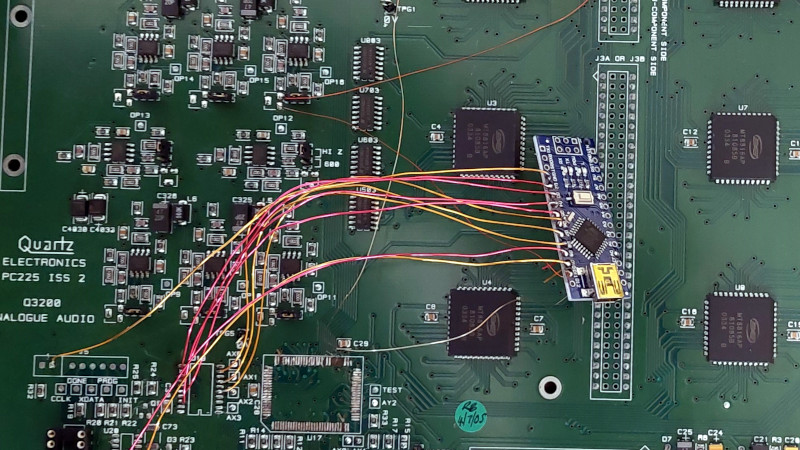The equipment used in professional radio and TV studios is both extremely high quality and very expensive indeed, and thus out of the reach of an experimenter. Happily as studios are refurbished there’s a steady supply of second-hand equipment which can be surprisingly cheap, but as [Nathan] found out with a Quartz audio router, comes with no control software. What’s to be done with what’s essentially a piece of junk? Remove its brain and replace it with one that can be controlled, of course!
On the PCB alongside a bank of switch matrices is an FPGA which does the heavy lifting. That’s “heavy” in a limited sense, because all it does is handle the chip select lines for the matrices and write data to their registers. This is a task that can be handled by a microcontroller, so in goes an Arduino Nano, which along with a few other board modifications delivers a serial-controlled studio router.
The interesting part for us in this project comes from a look at the date codes on the board, they’re from the early 2000s. This is (roughly) contemporary with the ATmega chip on the Arduino, so we’re curious as to why the designers saw fit to use an FPGA when the microcontrollers of the day were clearly up to the task for much less outlay. We suspect a touch of millennium-era price inflation, but we can’t be sure.
Meanwhile, old broadcast kit has featured here before.
















Amazing. Tons and tons of good stuff that lacks automation can be done sucessfully and cheaply today with a plethora of microcontrollers
I stopped questioning the price of audio gear, when I saw a volume knob made out of walnut wood.
For $400.
“For $2000, I’ll build you one that goes to 12.”
https://xkcd.com/670/
Exploitation is really built into some cultures, huh.
To be fair, this isn’t silly audiophile gear, but professional studio kit. The BBC don’t mess about with their specifications.
Well you could add wifi and Bluetooth and extra functionality using a 32bit esp32 and a serial spi flash
So you won’t even need a serial cable
And can control it 100 yards away with even a smartphone
Or anywhere on earth if you have an internet connection
Even from the iss if you really wanted to
Even from Voyager if you fixed the telemetry unit
I can control it remotely, serial port is connected to a server with a Web interface I can access from my phone via VPN anywhere 😁
😂
why do you point out that it’s 32 bit? It gives it absolutely no benefit in this application. and why would you use an SPI flash (and presumably, the bare chip and a self made pcb) when there are modules containing both for like a dollar?
I was thinking the same. The ESP 32 is amazing, at least to someone like me that it is just starting with microcontrollers
You ask why the fpga not a processor .
Looking at the desired use , this falls into a low volume board.
The Arduino , is a great thing, but I’d say in 2000 very few if any companies would stick what is viewed as a hackers board onto their system.
Ok they could put a processor on , but my bet is that the office was set up for either Fpga or big processor work.
So much easier to put in a small fpga that they were set up to use.
I was at a place , I had a great Arduino demo of the required system. A few hundred units needed. By the time it was finished , it needed a 600 MHz processor , and a pile of C++ code, and SD card.
I think you may have missed the point. The Arduino series arrived in the later half of that decade, they use the Atmel processors. An Atmel microcontroller or equivalent would have definitely been a good choice for an engineer in the early half of the decade. Nothing to do with an Arduino.
Say hello to my teensy 4.0. She has a arm cortex m7 on board that can run up to 1ghz.
I needed the archive link to see the project page.
https://web.archive.org/web/20231228150924/https://www.nathanmediaservices.co.uk/projects/?content=quartz_audio_router